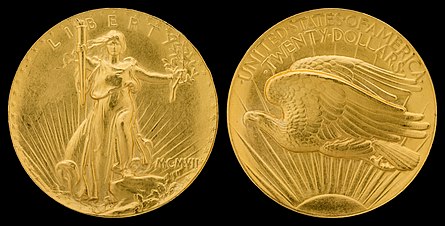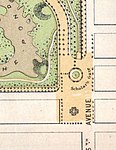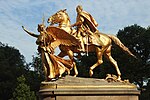William Tecumseh Sherman (Saint-Gaudens)
| William Tecumseh Sherman Victory | |
|---|---|
 The sculptures in 2016 | |
 | |
| Artist | Augustus Saint-Gaudens |
| Year | 1902 |
| Type | Sculpture |
| Medium | Bronze |
| Subject | William Tecumseh Sherman |
| Location | New York City, New York, U.S. |
| 40°45′52″N 73°58′24″W / 40.7645°N 73.9732°W | |
William Tecumseh Sherman, also known as the Sherman Memorial or Sherman Monument,[1][2] is a sculpture group honoring William Tecumseh Sherman, created by Augustus Saint-Gaudens and located at Grand Army Plaza in Manhattan, New York. Cast in 1902 and dedicated on May 30, 1903, the gilded-bronze monument consists of an equestrian statue of Sherman and an accompanying statue, Victory, an allegorical female figure of the Greek goddess Nike.[3] The statues are set on a Stony Creek granite pedestal designed by the architect Charles Follen McKim.[4]
History
[edit]The idea for the statue dates back to as early as 1888. The architect Charles Follen McKim and sculptor Augustus Saint-Gaudens decided in 1902 to install an equestrian statue of U.S. Army general William Tecumseh Sherman in Central Park.[4] Several sites had been considered, including Sherman Square on the Upper West Side; the median of Riverside Drive just south of Grant's Tomb; another site on Riverside Drive; and Grand Army Plaza.[5] The Central Park Mall was also considered but ruled out.[6] The statue was dedicated in the northern half of Grand Army Plaza on May 30, 1903.[7]
The plaza was re-landscaped in the 1910s after newspaper publisher Joseph Pulitzer died in 1911, bequeathing $50,000 for the creation of a memorial fountain.[8] As part of the fountain's construction, the Sherman Monument remained in the northern half, but moved 15 feet (4.6 m) west to be symmetrically opposite the fountain.[9]
On July 23, 1974, the Landmarks Preservation Commission designated Grand Army Plaza, including the Sherman Monument, as a New York City scenic landmark.[10] On March 26, 1985, the Central Park Conservancy and the architecture firm of Buttrick White & Burtis presented plans to the Landmarks Preservation Commission for a full restoration of the plaza, including the Sherman Monument.[11] The work was completed in June 1990, including a re-gilding of the statue, and the replacement of a palm frond and a sword that had been removed previously.[12] Grand Army Plaza was renewed again in 2013, including a re-gilding of the statue of William Tecumseh Sherman.[13]
Critiques
[edit]According to the report prepared by the Landmarks Commission for its 1974 designation, many consider the Sherman Monument to be Saint-Gaudens’ finest work. Not everyone agreed; according to Frank Weitenkampf,[14] sculptor John Quincy Adams Ward was less than enthusiastic about the equestrian composition: "Saint-Gaudens was a timid rider and it showed in this work.... if the horse should stumble the general would inevitably be thrown over his head."
Use on coinage
[edit]The obverse of Saint-Gaudens' 1907 United States Saint-Gaudens double eagle coin, portraying Liberty,[15] is based on his sculpture of Victory.
Gallery
[edit]-
Head detail of the Victory figure
-
1863 design showing a proposed fountain (before the plaza was extended south to 58th Street)
-
1868 Map of Central Park includes the future site of the Sherman Monument
-
1869 map of the plaza, showing a site for a clock tower near where the Sherman statue was located in 1903
-
A view of the Sherman Monument circa 1908–1915, before the creation of the Grand Army Plaza
-
Thomas Hasting's 1913 plan for the plaza, showing the relocated Sherman statue in the northern (upper) half
-
Augustus Saint-Gaudens, who sculpted the monument, photographed in 1905
-
Architect Charles Follen McKim designed the pedestal of the monument.
-
Detail of the Monument's pedestal
-
Southeast side
-
View looking southwest to Central Park South
References
[edit]- ^ "Sherman Memorial (sculpture)". Smithsonian Institution Research Information System. Retrieved November 4, 2015.
- ^ "William Tecumseh Sherman". Central Park Conservancy. Retrieved July 5, 2014.
- ^ Warner, Marina, Monuments and Maidens: The Allegory of the Female Form, University of California Press, Berkeley, California, 1985 pp. 16–17.
- ^ a b "Grand Army Plaza Monuments: William Tecumseh Sherman". New York City Department of Parks and Recreation. May 30, 1903. Retrieved June 21, 2024.
- ^ "Site for Sherman Statue". New-York Tribune. 1902-03-15. p. 7. Retrieved 2024-06-22.
- ^ "Location of Sherman Statue". New-York Tribune. 1902-02-28. p. 7. Retrieved 2024-06-22.
- ^ "Unveil Sherman Statue With Appropriate Service.: St. Gaudens' Magnificent Equestrian Work Formally Dedicated to the City of New York--Root Delivers Address". Chicago Daily Tribune. 31 May 1903. p. 33. ISSN 1085-6706. ProQuest 173114890; "Statue of Gen. Sherman Unveiled in Manhattan". The Brooklyn Daily Eagle. 1903-05-30. p. 2. Retrieved 2024-06-22; "Statue of Sherman Unveiled". New-York Tribune. 1903-05-31. pp. 1, 2. Retrieved 2024-06-22.
- ^ Landmark Preservation Commission (23 July 1974). "LP-0860" (PDF). NYC Landmark Designation Reports. Retrieved 12 March 2012.
- ^ "Comment by Mme. X". Chicago Daily Tribune. November 7, 1915.
- ^ Goldberger, Paul (July 24, 1974). "Carnegie Hill Areas at 5th Ave. Designated a Historic District". The New York Times. p. 43. ISSN 0362-4331. Archived from the original on January 27, 2024. Retrieved May 25, 2024.
- ^ Purnick, Joyce (March 27, 1985). "For a Historic Plaza, Pears or Limes?". The New York Times. p. B1.
- ^ Goldberger, Paul (June 28, 1990). "A Restored Grand Army Plaza, With a New Coat for the General: Bright gold is thought to be the Sherman statue's original finish". The New York Times. p. C13.
- ^ Dunlap, David (18 June 2013). "It's General Sherman's Time to Shine, but Not Too Much". The New York Times. Retrieved 19 May 2014.
- ^ Manhattan Kaleidoscope, Frank Weitenkampf, Charles Scribner's Sons, 1947, page 128.
- ^ Taxay, Don (1983). The U.S. Mint and Coinage (reprint of 1966 ed.). New York, N.Y.: Sanford J. Durst Numismatic Publications. pp. 308–309. ISBN 978-0-915262-68-7.
External links
[edit] Media related to William Tecumseh Sherman monument by Augustus Saint-Gaudens at Wikimedia Commons
Media related to William Tecumseh Sherman monument by Augustus Saint-Gaudens at Wikimedia Commons
- 1902 establishments in New York City
- 1902 sculptures
- 59th Street (Manhattan)
- William Tecumseh Sherman
- Allegorical sculptures in New York City
- Bronze sculptures in New York City
- Equestrian statues in New York City
- Monuments and memorials in Manhattan
- Outdoor sculptures in Manhattan
- Sculptures by Augustus Saint-Gaudens
- Sculptures in Central Park
- Sculptures of Nike
- Victory












